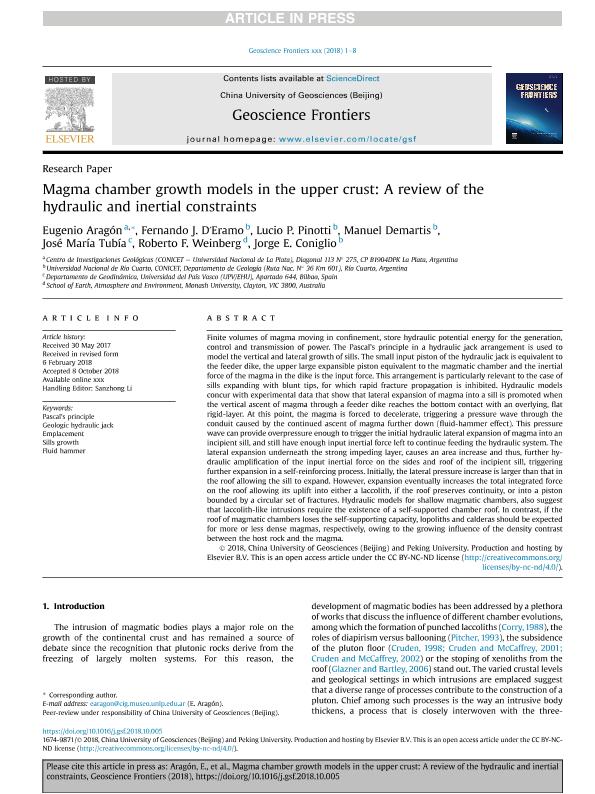Mostrar el registro sencillo del ítem
dc.contributor.author
Aragon, Eugenio

dc.contributor.author
D'eramo, Fernando Javier

dc.contributor.author
Pinotti, Lucio Pedro

dc.contributor.author
Demartis, Manuel

dc.contributor.author
Tubía Martinez, José María

dc.contributor.author
Weinberg, Roberto F.

dc.contributor.author
Coniglio, Jorge Enrique

dc.date.available
2020-08-25T14:56:27Z
dc.date.issued
2019-05
dc.identifier.citation
Aragon, Eugenio; D'eramo, Fernando Javier; Pinotti, Lucio Pedro; Demartis, Manuel; Tubía Martinez, José María; et al.; Magma chamber growth models in the upper crust: A review of the hydraulic and inertial constraints; Elsevier B.V.; Geoscience Frontiers; 10; 3; 5-2019; 1211-1218
dc.identifier.issn
1674-9871
dc.identifier.uri
http://hdl.handle.net/11336/112321
dc.description.abstract
Finite volumes of magma moving in confinement, store hydraulic potential energy for the generation, control and transmission of power. The Pascal´s principle in a hydraulic jack arrangement is used to model the vertical and lateral growth of sills. The small input piston of the hydraulic jack is equivalent to the feeder dike, the upper large expansible piston equivalent to the magmatic chamber and the inertial force of the magma in the dike is the input force. This arrangement is particularly relevant to the case of sills expanding with blunt tips, for which rapid fracture propagation is inhibited. Hydraulic models concur with experimental data that show that lateral expansion of magma into a sill is promoted when the vertical ascent of magma through a feeder dike reaches the bottom contact with an overlying, flat rigid-layer. At this point, the magma is forced to decelerate, triggering a pressure wave through the conduit caused by the continued ascent of magma further down (fluid-hammer effect). This pressure wave can provide overpressure enough to trigger the initial hydraulic lateral expansion of magma into an incipient sill, and still have enough input inertial force left to continue feeding the hydraulic system. The lateral expansion underneath the strong impeding layer, causes an area increase and thus, further hydraulic amplification of the input inertial force on the sides and roof of the incipient sill, triggering further expansion in a self-reinforcing process. Initially, the lateral pressure increase is larger than that in the roof allowing the sill to expand. However, expansion eventually increases the total integrated force on the roof allowing its uplift into either a laccolith, if the roof preserves continuity, or into a piston bounded by a circular set of fractures. Hydraulic models for shallow magmatic chambers, also suggest that laccolith-like intrusions require the existence of a self-supported chamber roof. In contrast, if the roof of magmatic chambers loses the self-supporting capacity, lopoliths and calderas should be expected for more or less dense magmas, respectively, owing to the growing influence of the density contrast between the host rock and the magma.
dc.format
application/pdf
dc.language.iso
eng
dc.publisher
Elsevier B.V.
dc.rights
info:eu-repo/semantics/openAccess
dc.rights.uri
https://creativecommons.org/licenses/by-nc-sa/2.5/ar/
dc.subject
EMPLACEMENT
dc.subject
FLUID HAMMER
dc.subject
GEOLOGIC HYDRAULIC JACK
dc.subject
PASCAL'S PRINCIPLE
dc.subject
SILLS GROWTH
dc.subject.classification
Geología

dc.subject.classification
Ciencias de la Tierra y relacionadas con el Medio Ambiente

dc.subject.classification
CIENCIAS NATURALES Y EXACTAS

dc.subject.classification
Física de los Fluidos y Plasma

dc.subject.classification
Ciencias Físicas

dc.subject.classification
CIENCIAS NATURALES Y EXACTAS

dc.title
Magma chamber growth models in the upper crust: A review of the hydraulic and inertial constraints
dc.type
info:eu-repo/semantics/article
dc.type
info:ar-repo/semantics/artículo
dc.type
info:eu-repo/semantics/publishedVersion
dc.date.updated
2020-08-21T15:42:03Z
dc.journal.volume
10
dc.journal.number
3
dc.journal.pagination
1211-1218
dc.journal.pais
Reino Unido

dc.description.fil
Fil: Aragon, Eugenio. Consejo Nacional de Investigaciones Científicas y Técnicas. Centro Científico Tecnológico Conicet - La Plata. Centro de Investigaciones Geológicas. Universidad Nacional de La Plata. Facultad de Ciencias Naturales y Museo. Centro de Investigaciones Geológicas; Argentina
dc.description.fil
Fil: D'eramo, Fernando Javier. Universidad Nacional de Rio Cuarto. Facultad de Cs.exactas Fisicoquimicas y Naturales. Instituto de Ciencias de la Tierra, Biodiversidad y Ambiente. - Consejo Nacional de Investigaciones Cientificas y Tecnicas. Centro Cientifico Tecnologico Conicet - Cordoba. Instituto de Ciencias de la Tierra, Biodiversidad y Ambiente.; Argentina
dc.description.fil
Fil: Pinotti, Lucio Pedro. Universidad Nacional de Río Cuarto; Argentina
dc.description.fil
Fil: Demartis, Manuel. Universidad Nacional de Rio Cuarto. Facultad de Cs.exactas Fisicoquimicas y Naturales. Instituto de Ciencias de la Tierra, Biodiversidad y Ambiente. - Consejo Nacional de Investigaciones Cientificas y Tecnicas. Centro Cientifico Tecnologico Conicet - Cordoba. Instituto de Ciencias de la Tierra, Biodiversidad y Ambiente.; Argentina
dc.description.fil
Fil: Tubía Martinez, José María. Universidad del Pais Vasco - Euskal Herriko Unibertsitatea, Campus Bizkaia;
dc.description.fil
Fil: Weinberg, Roberto F.. Monash University; Australia
dc.description.fil
Fil: Coniglio, Jorge Enrique. Universidad Nacional de Río Cuarto; Argentina
dc.journal.title
Geoscience Frontiers
dc.relation.alternativeid
info:eu-repo/semantics/altIdentifier/url/https://www.sciencedirect.com/science/article/pii/S167498711830210X?via%3Dihub
dc.relation.alternativeid
info:eu-repo/semantics/altIdentifier/doi/https://doi.org/10.1016/j.gsf.2018.10.005
Archivos asociados
